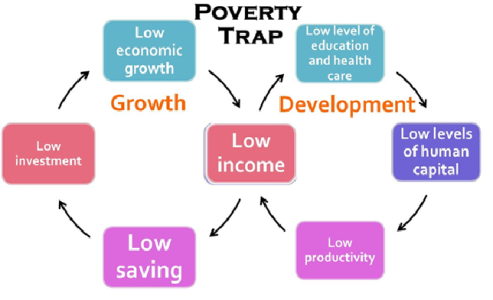Context
Examining the dynamics of urban poverty, particularly within the context of employment and income trends, becomes imperative in understanding the complexities of economic growth and distribution in India. The India Employment Report (IER) 2024, a collaborative effort between the Institute for Human Development and the International Labour Organization, raises pertinent questions regarding the trickle-down effects of economic growth on the working class against the backdrop of a 5.4% average real economic growth from 2015-16 to 2022-23. The report underscores a noteworthy divergence between rural and urban areas concerning employment and income, spotlighting higher unemployment rates in urban settings juxtaposed with relatively elevated wages.
Employment Dynamics in Urban Areas
The IER 2024 elucidates a nuanced picture of employment trends, indicating a higher unemployment rate in urban locales, standing at 4.8% in 2000 compared to 1.5% in rural areas. However, despite the unemployment disparity, urban areas exhibit significantly higher average monthly earnings across various employment categories by 2022. This intriguing coexistence of elevated wages alongside heightened unemployment warrants closer scrutiny to unravel its implications, particularly for the urban poor. The phenomenon of rural-urban migration, historically driven by the promise of higher income and improved quality of life, has undergone subtle shifts. While overall migration rates have surged, there's a discernible decline in male migration, signaling a waning allure of urban migration for economic advancement.
Survey Findings: Unveiling Urban Poverty
Delving into the microcosm of urban poverty, particularly within Kolkata's sprawling slums, provides invaluable insights into the lived experiences of the urban poor. A survey conducted across 37 slums in Kolkata in 2012 and revisited in 2022-23 reveals nuanced shifts in employment and income dynamics. Despite limitations in tracking due to redevelopment or eviction, data from 29 slums shed light on the employment landscape. Unskilled labor emerges as the cornerstone of employment in these slums, mirroring national trends where a substantial portion of the workforce is engaged in unskilled work.
Occupational Trends in Slums
Over the decade under scrutiny, major occupational categories within slums exhibit both stability and evolution. Unskilled labor remains a steadfast occupation, sustaining a significant portion of the workforce. However, the landscape witnesses subtle transformations, with declines observed in employment within skilled or semi-skilled labor and private organizations. Conversely, there's a notable uptick in engagement with petty businesses or small shops, signaling adaptive responses to economic exigencies within the slum ecosystem. Emerging occupations such as truck driving and cleaning, alongside construction-related work, underscore the fluidity and adaptability characterizing urban informal economies.
Income Dynamics: Realities of Urban Poverty
Analyzing income trends within slum communities underscores the harsh realities of urban poverty. Despite urban settings typically offering higher income opportunities, slum dwellers face myriad challenges. The average monthly income, which stood at around ₹4,900 in 2012, witnessed a slight decline by 5% in 2019 at constant prices. Notably, government employees, despite enjoying the highest incomes, experienced a 5% decline in real income over the same period. Conversely, those employed in domestic services and unskilled labor witnessed persistently low incomes, underscoring entrenched inequalities within urban settings.
Gender Dynamics in Urban Employment
Gender compositions within different occupational categories in Kolkata's slums unveil complex patterns of workforce participation. While the percentage of women in the workforce experienced a marginal decline, broader trends depicted by the IER 2024 highlight a contrasting increase in female workforce participation. This divergence underscores nuanced shifts in urban employment dynamics, with implications for gender equality and economic empowerment.
Rise of Casual Labor: Implications for Urban Poor
A notable trend observed in both the survey data and the IER 2024 is the rise of casual labor, particularly within urban settings. While this surge is accompanied by increasing wages, the precarious nature of casual work underscores the vulnerability of the urban poor. In contrast, self-employment avenues such as petty businesses witness a rising trajectory, albeit without commensurate income growth. This trend underscores a burgeoning population of low-earning entrepreneurs within urban slums, grappling with economic uncertainties and lack of social security nets.
Addressing Urban Poverty: Towards Inclusive Growth
The confluence of declining incomes, shifting employment patterns, and persistent inequalities underscores the imperative for targeted interventions to uplift the urban poor. The decline in male migration, coupled with sluggish growth in agricultural sectors, underscores the need for comprehensive policies aimed at fostering inclusive growth and economic mobility. Enhancing access to gainful employment, coupled with provisions for social security and affordable housing, becomes paramount in mitigating urban poverty's entrenched challenges.
Conclusion
The intricate tapestry of urban poverty in India demands multifaceted approaches, blending policy interventions with grassroots initiatives. The findings from the IER 2024, alongside localized surveys within urban slums, provide invaluable insights into the realities faced by the urban poor. Addressing the structural barriers impeding economic mobility and quality of work necessitates concerted efforts aimed at fostering inclusive growth and social equity. As India navigates the complexities of urbanization and economic transformation, prioritizing the needs of the urban poor remains imperative for sustainable and equitable development.
|
Probable Questions for UPSC Mains Exam 1. What are the primary factors contributing to urban poverty in India, and how can policy interventions be tailored to address the challenges faced by the urban poor effectively?(10 marks, 150 words) 2. How do shifting employment patterns and declining incomes impact the urban poor? Discuss strategies to enhance economic opportunities and social inclusion for marginalized communities in urban areas.(15 marks, 250 words) |
Source – The Hindu







